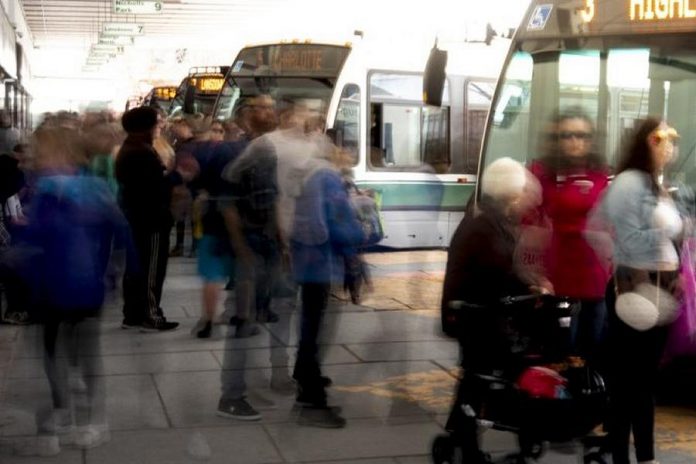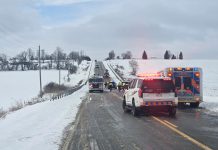
The speed of a major overhaul to Peterborough Transit routes because of provincially mandated COVID-19 health safety measures is creating consternation among bus drivers, according to the local union president.
Among several changes taking effect June 28 is a reduction in the number of bus routes from 12 to nine, with just five of those routes going directly to the Simcoe Street terminal. Up to this point, all 12 bus routes led to the downtown Peterborough terminal. In addition, three new community bus routes are being added and bus stop locations are changing.
While acknowledging the more grid-like route changes are mostly an improvement over the status quo, the president of Local 1320 of the Amalgamated Transit Union that represents bus drivers and garage staff is concerned over the speed with which the changes are being put into effect.
“We pictured a slower implementation so drivers and passengers can get used to it,” says Tyler Burns. “It’s being tossed at us and we’re going to have to hit the ground running.”
“I hope it’s a smooth transition because I think it is time for our transit system to grow up and grow for the better. It would be a real shame if this stumbles hard and we have to wait another 10 years to try something like this out again. My main concern, as it always is, is the safety of my members.”
While acknowledging that the timeline is tight, City of Peterborough transit manager Laurie Stratton says mandated pandemic health safety measures have necessitated the fast tracking of the new route system. She recognizes the speed of the changes has had an impact on transit riders as well as drivers.
“Transit has been making the necessary changes at breakneck speed, responding to the focus on public safety as well as mandates put out to all public transit authorities to deliver safe service to customers as well as keep employees safe,” she says.
“Our customers have adjusted to rear door boarding. They have adjusted to expectations regarding physical distancing and seat limits, and having to wait patiently while we run overflow buses or bring buses in from stand-by locations. This change is another in a series of changes that have come at them quickly.”
Stratton points out there normally would have been a traditional consultation process before implementing changes of this scope, but the summer months provide an opportunity for on-the-fly consultation before the busier fall season.
“Typically we would have had traditional consultation. We plan to have that going forward. With our ridership low right now, we’re looking toward a fall ridership increase. Can we make these changes in September? That’s unthinkable. This July/August timeline while our ridership is lower gives our drivers and customers the opportunity to experience it and learn about the changes, and for us to gather feedback, prior to the busier fall.”
Peterborough Mayor Diane Therrien admits the new transit route system has been rolled out quickly, “like everything that we’ve done in response to COVID-19,” adding, “we don’t have the luxury of time.”
“Under the state of emergency, staff is empowered to make some of the decisions they have to make to ensure public health and safety. They’ve been really good at informing council of any changes. In a normal year there would probably be a staff recommendation to change some things. There are budgetary implications when you’re running more buses or running less buses. Something like that would come to council for the okay.”
Mayor Therrien notes one positive outcome of the new route system will be less crowding at the downtown terminal, which speaks directly to the physical distancing requirement. She adds that bio-shields to protect drivers will be installed at some point in July, creating the ability to again collect fares again — an important consideration during a year that has seen the city lose many of its regular revenue streams.

While Burns gets that driver and passenger safety is the motivation for bringing in the new route system quickly, he says he’s looking for even quicker answers on their effect on drivers.
“Traditionally drivers have had their lunch breaks either at the terminal or the bus garage, but with these changes that will no longer be the case,” he notes. “We’ll have people have their lunch at Lansdowne Place, at Trent University, and at Fleming. We’re not 100 per cent sure on the logistics of that — what we’ll have access to, what we won’t have access to.”
“It’s pretty apparent it won’t be business as usual come the fall, so we’re not sure what we’ll have available in terms of facilities, or access to a kitchen or a hand-washing station,” Burns adds. “We have just a few days before the changes come into effect. I like to know there’s something set in stone by then in terms of what drivers will be doing for breaks and meals.”
Regarding that concern, Stratton says management is working with driver trainers to solicit feedback on how to best accommodate meals and breaks at locations other than the terminal or garage.
“Feedback about the (people) crunch at the terminal, this has been a historic complaint of our drivers. This new system addresses that. We’ve heard a lot of concerns from our drivers about crowding on limited peak time buses. This addresses that as well.”
“If we had not changed the routes, the option was reducing service. We’re here to support the community through its economic and social recovery. We’re trying to get the trust of the public, to let them feel confident to use transit. Jamming them down here at the terminal or jamming them into the limited peak time buses is not a safe way to do that.”
Along with the implementation of the new transit route system, a possible second challenge is looming.
Should Trent and/or Fleming not be open in September for traditional classes, transit ridership will take a major hit. Student fares bring in about $1.6 million annually. Unless other levels of government step up with funding to offset any major loss of revenue, a reduction in routes is possible that, in turn, could possibly result in driver layoffs.
“It’s a tough budget year and we don’t want to be losing any more money than we already are,” says Mayor Therrien.
Union concerns aside, the new transit route system will roll out June 28. Both Stratton and Burn do totally agree on one thing — the need for transit users to give the changes a chance to succeed.
“Change is always a challenge,” says Stratton. “We expect both positive and negative reaction.”
“The biggest thing with transit is to try and optimize what you can deliver to the most people. We know this new system will mean some folks will have to travel a little further to get to their stop, and that they will experience untimed on-the-street transfers. That’s new. But what it allows us to do is reduce overall travel times. We don’t want people on the bus longer than they need to be in a confined space.”
“I urge the public to be patient with the drivers,” adds Burns. “We’re learning the new route system at the exact same time as everybody else.”
“Tt’s going to be frustrating for drivers. Passengers are going to be frustrated too. There’s various ways to contact the city and transit management with your concerns, so take advantage.”
The new routes and other information can be viewed at www.peterborough.ca/transit. Transit customers can provide feedback on the new routes at forms.peterborough.ca/Transit/Transit-Feedback-New-Routes.


























